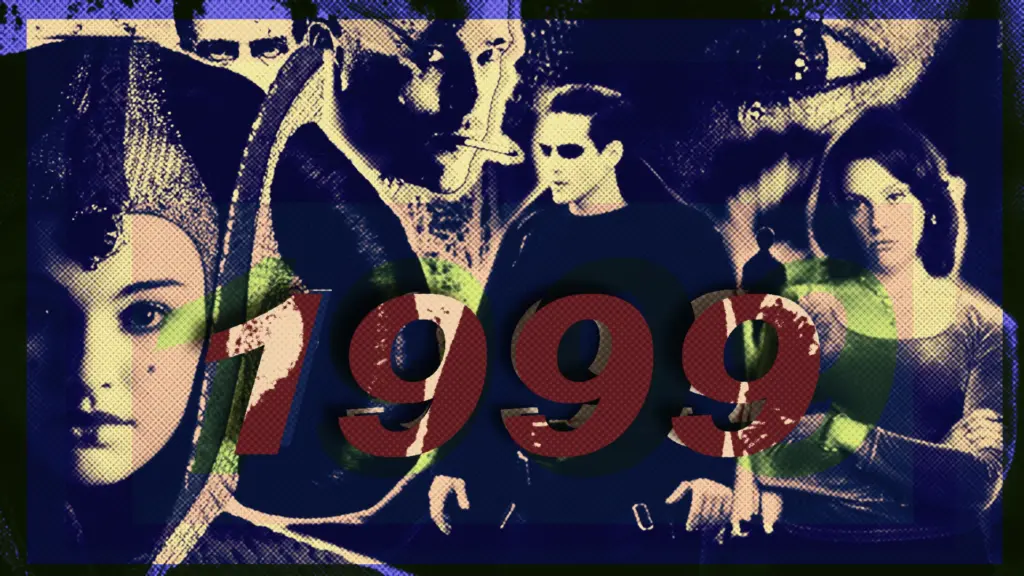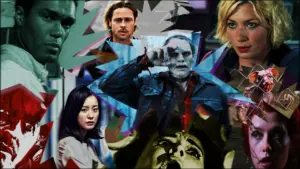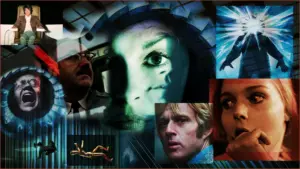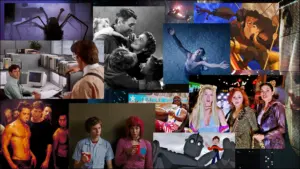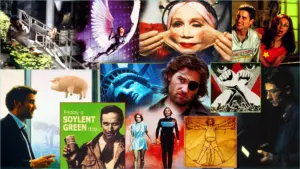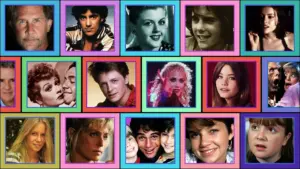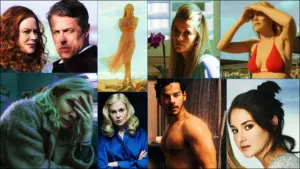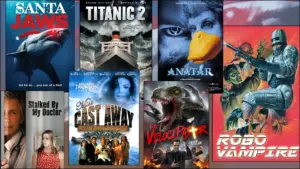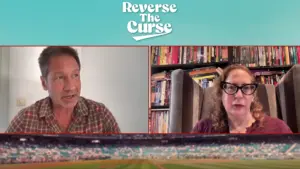By 2024 it has become conventional wisdom that 1999 was an unusually good year for movies. It is hard to imagine a year with releases from auteurs Kubrick, Scorsese, Lynch, Paul Thomas Anderson, and Sofia Coppola being anything but great. Among the many cinephilic paeans to that annus mirabilis (try saying that five times fast) is Brian Raftery’s 2019 book Best. Movie. Year. Ever.: How 1999 Blew Up the Big Screen.
Of course, the idea of “best” is ambiguous and in this context almost always means best Hollywood movies. Sometimes the Best Foreign Language Oscar winner All About My Mother will be invoked, but rarely are international masterpieces like Beau Travail, Audition, After Life, or even Palme d’Or winning Rosetta mentioned when extolling the greatness of the year.
That’s partly because the high standing of 1999 lies not only in the quantity of good movies but in the way they heralded things to come. Many of the films exemplify trends that would soon dominate 21st Century Hollywood.
I recently rewatched five of the most influential films to see how they hold up a quarter century later. Here is what I found.

The Sixth Sense
It’s probably not a surprise to see The Sixth Sense on this list, but in 1999 it was certainly a surprise how huge its box office gross was, second only to the first Star Wars prequel that came with an unprecedented level of pent-up demand. In retrospect it seems clear that one of the reasons writer-director M. Night Shyamalan’s ghost story caught fire was word of mouth and the feeling that you had to see this film right away before you accidentally found out the twist ending.
It turns out – non-spoiler alert! – The Sixth Sense is also a really good movie. It’s got a great sense of mood and clever camera work. In many ways it’s just as silly as Shyamalan’s more recent work, but if you’re in the right mood it’s also a fun and effective PG-13 horror movie. (For my money it’s scarier than Poltergeist.)
Yet for Shyamalan The Sixth Sense became a kind of curse. After its success he struggled to escape the pigeonhole labeled “twist endings.” Indeed, 25 years later moviegoers seem to still demand plot twists, especially in horror movies. And our cultural obsession with spoilers, catalyzed by The Sixth Sense,has reached the point that many people seem to assume a movie is good only if it has a twist that’s possible to spoil.

The Blair Witch Project
Another surprise horror hit from 1999 also benefitted from word of mouth. The marketing for The Blair Witch Project initially presented itas nonfiction, a lie that worked to make the film seem scarier. But even today with full knowledge of the movie’s fakery, it holds up.
What this crew of naive 20-something filmmakers pulled off with this self-made microbudget horror movie is low-key miraculous. They took a great idea — to frame a horror movie as behind-the-scenes footage of an ill-fated paranormal documentary, improvisationally self-shot by the actors themselves — and executed it so perfectly that “found footage” has become a common sub-genre of horror.
It’s fascinating to see how directors Daniel Myrick and Eduardo Sánchez (who also get editing credit) build a movie out of more-or-less abstract images, illegible shaky closeups of the woods, and completely underexposed night shots. Despite a quarter century of imitators, the Blair Witch footage is somehow uniquely unsettling, especially when you can’t really see what’s there, yet again confirming the Jaws maxim that what you don’t see is scarier. Plus it’s interesting to look at, too. The noisy analog photography — intercutting Hi8 video tape and 16mm film — always lent the movie an air of creepy authenticity, but it looks even better now that it plays as a retro lo-fi aesthetic.

Star Wars: Episode I – The Phantom Menace
While The Blair Witch Project had basically no special effects, The Phantom Menace is basically all special effects. The highest grossing movie of 1999 not only kicked off an ongoing Hollywood fixation on prequels, it also made much more extensive use of CGI animation than anything up to that point.
Even compared to current standards The Phantom Menace looks great. It’s one of the earliest movies to have establishing shots that are entirely CG and master shots that are often just CG backgrounds with live actors and props. For the most part the effects hold up. The biggest weakness of the effects is that the fully CG characters (there are lots, not just the much maligned Jar Jar Binks) don’t seamlessly blend in with the live action elements, but for the most part director George Lucas understands the limits of the technology and generally uses it only when he can get good results. Part of his success is due to actually lighting the actors to match the backgrounds. Nothing is too flat or too dark to see. And it’s all plenty colorful, too. No MCU-style gray sludge here.
I’ve never hated Episode I as much as most people my age. Yes, the screenplay is seriously flawed, but overall the movie still undeniably feels like Star Wars, which is more than I can say for some of the newer Disney+ “content.”

The Matrix
One of the reasons The Phantom Menace was so poorly received in 1999 is that it had the misfortune of premiering a mere six weeks after The Matrix.
Revisiting this masterpiece for the first time in more than a decade, that opening scene with Trinity and the cops remains breathtaking. And all the overwritten philosophical dialogue in the first half is among the most riveting exposition in cinema. Scene for scene, The Matrix stands beside the original Star Wars as one the greatest sci-if films of all time.
It’s got loads of jaw-dropping action choreography and special effects, of course, but in retrospect less CGI and way more real stunts than we see in similar movies today. It is largely due to this film that when a movie star is cast in an action film, they typically receive at least some training in martial arts.
But The Matrix is not only a ground-breaking action film, it’s also a brilliant live-action adaptation of anime tropes. (Has as any other live-action adaptation of a cartoon aesthetic ever actually worked besides the Wachowskis’ other masterpiece Speed Racer?) Plus it’s a master class in pacing and editing that has lost none of its power in the years since its release.
It’s ironic that The Matrix’s metaphorical framework has been co-opted by right-wing “red-pill” bros, since it’s pretty obviously a Marxist allegory. The dominant ideology of the film’s evil Agents is techno-capitalism combined with white supremacy — ever notice that almost everyone inside the matrix simulation is White, while most people in the real world of Zion are people of color? — and, thanks to the film’s transgender creators, a heavy dose of patriarchy in subtext.
I mean, The Matrix ends with a Rage Against the Machine song literally screaming at us to “wake up.” How much more woke does a movie need to be before audiences get it?

Fight Club
Not all the influential films of 1999 were hits. Director David Fincher’s Fight Club was a box-office bomb upon release, but steadily gained cult status and then transmogrified into a symbol of something quite different.
Rewatching it now, Fight Club seems prophetic in the way it predicted the American alt-right’s reaction to the decline of patriarchy. Through the character of Tyler Durden (played by Brad Pitt), the movie articulates postmodern men’s feeling of emasculation and rage so well the so-called manosphere began to unironically adopt Tyler’s poisonous philosophy. Somehow male viewers regularly miss the fact that Tyler is the villain of the film, whose male aggression curdles into fascism in the second half of the movie. As a hypermasculine alternative to therapy, Tyler’s nihilism is so insidiously attractive many male viewers don’t see the changeover in the third act when the protagonist (Ed Norton) realizes a man’s true liberation from alienation and meaningless conformity can only come from taking responsibility for his life and opening his authentic self to the sort of emotional vulnerability that makes relationships with women possible.
Along with The Matrix, the reception of Fight Club foreshadows the 21st Century culture wars and how people can read films very differently depending on their political perspective. At the same time, Fincher pulls off a masterful use of “invisible” CG at least as groundbreaking as the effects in The Phantom Menace. I hope Fight Club’s legacy can outlive the angry White dudes who give it a bad name.

